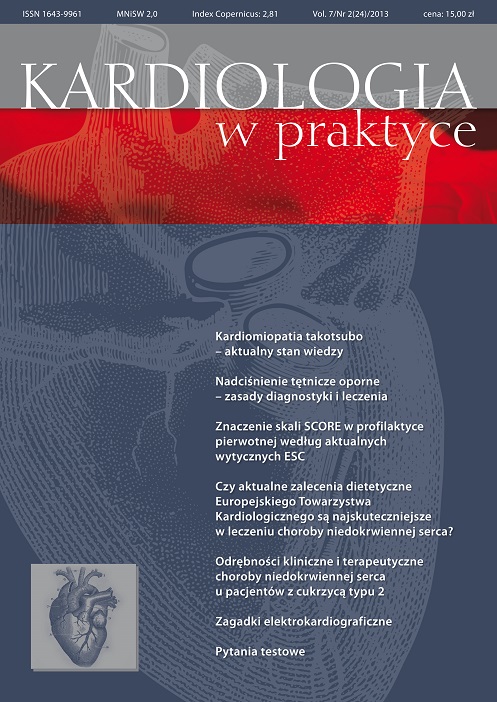The importance of SCORE scale in primary preventive maintenance according to current ESC guidelines Review article
Main Article Content
Abstract
Cardiovascular diseases are the leading cause of death in the world and they contribute to disability, decreased quality of life and loss of ability to work affecting the increasing cost of medical care. In 1969 WHO called it the greatest epidemic that human had to deal with. In Poland, since 1991, we observe a significant reduction in the mortality rate, to the large extent due to prevention. Tools used to assess of cardiovascular risk has evolved over the years. A break through was SCORE (Systematic Coronary Risk Evaluation) Project. In May 2012 European Society of Cardiology announced a new guidelines concerning the prevention of cardiovascular disease. They recommend assessment of total cardiovascular risk among all adults without evidence of cardiovascular disease and suggest that the preferred tool should be the SCORE scale.
Downloads
Article Details

This work is licensed under a Creative Commons Attribution-NonCommercial-NoDerivatives 4.0 International License.
Copyright: © Medical Education sp. z o.o. This is an Open Access article distributed under the terms of the Attribution-NonCommercial 4.0 International (CC BY-NC 4.0). License (https://creativecommons.org/licenses/by-nc/4.0/), allowing third parties to copy and redistribute the material in any medium or format and to remix, transform, and build upon the material, provided the original work is properly cited and states its license.
Address reprint requests to: Medical Education, Marcin Kuźma (marcin.kuzma@mededu.pl)
References
2. Perk J., De Backer G., Gohlke H. et al.: European Guidelines on cardiovascular disease prevention in clinical practice (version 2012). The Fifth Joint Task Force of the European Society of Cardiology and Other Societies on Cardiovascular Disease Prevention in Clinical Practice (constituted by representatives of nine societies and by invited experts). Developed with the special contribution of the European Association for Cardiovascular Prevention & Rehabilitation (EACPR). Eur. Heart J. 2012; 33(13): 1635-701.
3. De Backer G., Ambrosioni E., Borch-Johnsen K. et al.: European guidelines on cardiovascular disease prevention in clinical practice. Third Joint Task Force of European and Other Societies on Cardiovascular Disease Prevention in Clinical Practice. Eur. Heart J. 2003; 24(17): 1601-1610.
4. European Association for Cardiovascular Prevention & Rehabilitation; Reiner Z., Catapano A.L., De Backer G. et al.: ESC/EAS Guidelines for the management of dyslipidaemias: the Task Force for the management of dyslipidaemias of the European Society of Cardiology (ESC) and the European Atherosclerosis Society (EAS). Eur. Heart J. 2011; 32(14): 1769-818.
5. Mosca L., Banka C.L., Benjamin E.J. et al.: Evidence-based guidelines for cardiovascular disease prevention in women: 2007 update. Circulation 2007; 115(11): 1481-501.
6. Graham I., Atar D., Borch-Johnsen K. et al.: European guidelines on cardiovascular disease prevention in clinical practice: full text. Fourth Joint Task Force of the European Society of Cardiology and other societies on cardiovascular disease prevention in clinical practice (constituted by representatives of nine societies and by invited experts). Eur. J. Cardiovasc. Prev. Rehabil. 2007; 14(Suppl. 2): S1-113.
7. Mancia G., De Backer G., Dominiczak A. et al.: 2007 ESH-ESC Practice Guidelines for the Management of Arterial Hypertension: ESH-ESC Task Force on the Management of Arterial Hypertension. J. Hypertens. 2007; 25(9): 1751-62.
8. World Health Organization, Regional Office for Europe. The Prevention and Control of Major Cardiovascular Diseases. Report of a Conference.1973. Report No Euro 8214.
9. Capewell S., O’Flaherty M.: Rapid mortality falls after risk-factor changes in populations. Lancet 2011; 378: 752-753.

